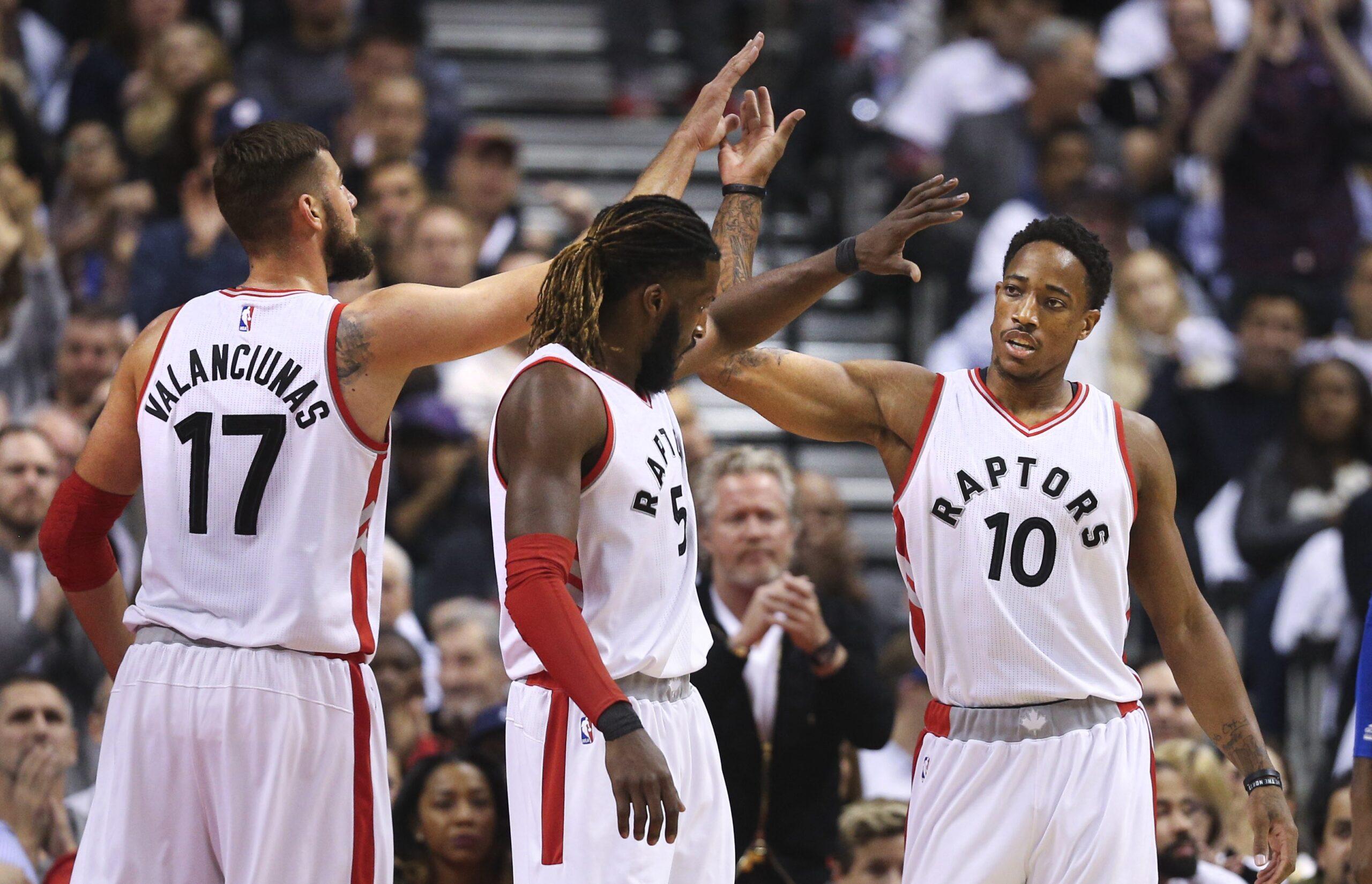
Sometimes, all basketball is the experience of watching one man cook. “It’s one thing to watch somebody on TV and see what he does every single night,” Raptors rookie Pascal Siakam said of DeMar DeRozan’s opening-night performance after Wednesday’s 109–91 win over the Detroit Pistons. “Actually being there and seeing how effortless it was, it was amazing. It was just like poetry. He was just out there, getting to his spots, shooting over people. It was just like, ‘How does he do that?’ It was amazing.”
DeRozan scored 40 points against the Pistons on 17-of-27 shooting, and it took only three quarters for him to do it. On a night when his backcourt mate Kyle Lowry struggled, DeRozan picked up all of the slack. It was a vintage performance, though not vintage DeMar. This was one of the best games of his career; “early Christmas,” as he’d call it in a postgame interview. With his wide spins and angular footwork, his hang time finishing through contact on slashes to the rim, and his own crisscrossing juke en route to a demoralizing jumper from the top of the key, the actual vintage could’ve been anywhere between 1998 Jordan and 2010 Kobe.
For a moment, you suspend your disbelief, and that’s the problem with DeRozan and the team he’s helped shepherd for the past seven seasons and counting. The moments just don’t last long enough.
How much you believe in the Toronto Raptors as a viable championship contender depends on your willingness to bring a knife to a gunfight. In an age when we have enough data to support much of what we see on the basketball court, where you stand on Toronto depends on your faith in the intangibles of chemistry and identity. More specifically, it depends on your faith in how much further good chemistry can take a team that is what it is.
The Kyle Lowry–DeRozan partnership has been fruitful for years, and last season, as the two jointly enjoyed their best campaigns as pros, they became one of the league’s best duos, period. It’s a relationship that has manifested beyond basketball, and the league has taken notice. Witnessing the connection up close in Rio over the summer, Kevin Durant texted former Thunder and current Raptors assistant coach Rex Kalamian, marvelling at their synchronicity. Kalamian paraphrased what Durant had told him to the Toronto Star: “Your two guys are the best. I’m jealous of their relationship, the way they get along with each other and the way they play together. The way they enjoy each other, it’s great.”
A KD cosign might not have as much cultural capital as Drake’s (at least north of the border), but it’s meaningful in this context: The Raptors now assume a similar position to the one Durant’s old Thunder teams had before — they are one of the elites in their conference caught in a most enviable purgatory where simply being one of the best teams in their conference isn’t enough. Durant had to venture elsewhere to find what he was missing; his effusiveness regarding the Raptors’ tentpole talents suggests the team might already have the proper emotional framework. The Raptors just have to figure out if they have the proper talent.
Toronto had a near-perfect opening game against the Pistons, who figure to be one of the best teams in the East for years to come. But it’s a long season, and you’re looking for signs of growth, for direct adjustments to what caused their demise during last season’s playoffs.
It was an emphatic win for the Raptors as a brand of basketball: Lowry, the oldest player on the roster, played the most minutes on the team in a 18-point win; Norman Powell, who was a rock-solid contributor (and possibly one of the team’s best defenders already) last season as a rookie, could log only two minutes of garbage time (it takes coach Dwane Casey a while to warm to younger players, though this season injuries forced his hand); DeRozan dropped 40 without hitting a 3, which, spiritually, is the same as J. Cole going double platinum with no features.
This is all nitpicking, but DeRozan isn’t going to shoot 64.3 percent from midrange every night. Most nights he’ll be closer to 38 and 35.8 percent, his figures in the past two seasons. He is one of the absolute best scorers out of the pick-and-roll, cashing in nearly a point per possession, second to only Steph Curry last season among players who took at least 300 field goal attempts out of the play type. Curry and DeRozan had the exact same field goal percentage (48.1 percent) out of the pick-and-roll, but Curry’s effective field goal percentage (which factors in the fact 3-pointers are 1.5 times more valuable than 2-pointers) was 12.8 percentage points higher than DeRozan’s, whose eFG went up by two-tenths of a point compared to Curry’s 13-point increase.
Nearly a third of DeRozan’s active offensive possessions come out of the pick-and-roll. It’s part of what makes his partnership with Lowry so effective; his ever-improving ability to handle the ball and facilitate allows Lowry to work off the ball, where he’s become increasingly accurate as a spot-up shooter. But there’s another world that the Raptors haven’t yet explored; all it’d really take is for DeRozan to add even the threat of taking a 3 in the pick-and-roll.
The idea of versatility dominates modern basketball discourse, but it’s often used as shorthand for the league’s new predominant style of pace and space. Big men are expected to be hybrids with 3-point range. It’s not necessarily that dogmatic, though. Teams in this era just need to be able to adjust to opponents. There may not be any one way to win at basketball, but the game is also moving beyond the idea that a team can inhabit only one specific identity at a time. The Grizzlies have upgraded their firmware, but their native ports are still Zach Randolph–compatible. Memphis had to get a new coach, a branding overhaul, and years of postseason deadlock, but the Grizzlies have made necessary changes to survive in a league where they can no longer impose themselves upon their opponents in a traditional sense. The Raptors got the branding part right, but have lacked a degree of on-court flexibility, though it was largely due to the absence of DeMarre Carroll for much of last season. Carroll is still working his way back to 100 percent after recovering from right knee surgery, but he’s the type of hybrid that can allow the Raptors to play small when they need to. Casey used Carroll solely as a 3 against Detroit, but against teams that don’t have a surplus of giants, we might see more colorful lineups once Carroll is fully up to game speed.
Or they could just not compromise. There’s always that. For the past three seasons, Jonas Valanciunas has been the closest thing Toronto has to a wild card. Every year, something gets in the way (foul trouble, Casey’s lack of trust in his ability to close quarters, injuries) and he’s become a hollow symbol of the Raptors’ own short-term improvements in the shadow of long-term stagnation. But if there’s hope for an actual Toronto transformation, we saw a glimpse of it on Wednesday.
Valanciunas played over 35 minutes against the Pistons, logging 32 points and 11 rebounds in the process. This is extremely significant. In the 306 regular-season and playoff games he’s played in his first four seasons, he’s surpassed the 35-minute threshold only 30 times. It’s a rarity for big men of this era to play heavy minutes night in and night out, partially due to a leaguewide acceptance of small ball, and partially because most big men just aren’t asked to shoulder as big an offensive load as before; there were only 10 centers last year who started at least 40 games and averaged at least 30 minutes a game. It’s always been an intriguing thought experiment with Jonas; his numbers over the years have always begged for extrapolation — the stats are stellar when adjusted per 36 minutes. What if he actually played that many minutes per game?
Valanciunas had an extra dose of energy against the Pistons, and was aggressive in finding his own shot early on. There are endearing things about his unvarnished offensive game, like his incredibly goofy shot fake with his arms way over his head that is shockingly effective for how infrequently he actually takes jumpers. But the most appealing offensive weapon in Jonas’s arsenal has been with him for basically as long as he’s been playing basketball: He’s a really good free throw shooter.
At 7 feet tall with an estimated 7-foot-5 wingspan and inarguably weighing more than his listed 260 pounds, he is a beacon for contact around the rim, and unlike most centers who share his bruising style of play, he’s a career 77.5 percent free throw shooter. Valanciunas shot 12-for-14 from the line against Detroit, who put all of Andre Drummond, Aron Baynes, and Boban Marjanovic on him to no avail. His ability to capitalize on free points as a center is the most interesting thing about his game, and it’s the one real market inefficiency that the Raptors have tapped that few others can. His knack for generating offensive boards and getting opposing big men in foul trouble without hurting them in a Hack-A situation could be a way the Raptors turn the tables on more modern schemes.
The Raptors will face the Cleveland Cavaliers on Friday, a team that has forged a chemistry and identity through its title run and might just be East-proof. Even if they hadn’t, LeBron James alone is enough to make any team East-proof. There is a strangeness to the Raptors’ current position in the NBA landscape. They aren’t their own team; they can’t just outperform the historical expectations of their franchise to achieve national recognition. There is an unshakable fatalism attached to being second-best, to knowing you’re second-best.
The Raptors could keep setting new records and standards for their franchise and know full well that it won’t be enough. The new record they have their eyes on this year? Four straight postseason appearances. Their clash against LeBron and Co. will be billed as an Eastern Conference finals rematch, but we all know it means less than that. In this purgatory of really good, the only thing that resonates is how it all ends.

